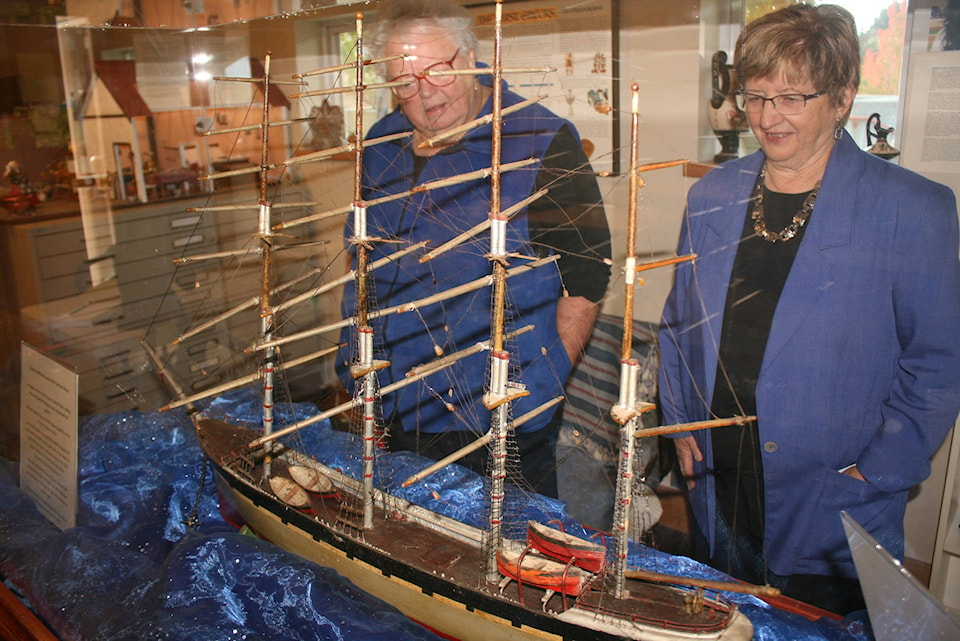In a little corner of Saanich, volunteers have recorded the earliest Greek immigrants to Victoria.
Curator Wendy Smylitopoulos leads the Greek Heritage Museum Project, which houses a variety of Greek artifacts in a small building on the back of the Greek Community Hall (beside Saanich Commonwealth Place).
It also tracks family trees and, in a few cases, a line can be drawn from current residents back to the first wave of Greeks that set foot here.
Among the museum’s greatest treasures is a model brigantine boat, encased in glass, that arrived with Nikolas Kapiotis at Fort Victoria in 1852. The seafaring Kapiotis is the first known Greek resident in town.
A little later, George Vienna, who is believed to have been a soldier of fortune in Mexico, passed through Victoria while seeking a different sort of fortune in the Cariboo.
“He returned in 1860 and married a 16-year-old Songhees a princess, Maryanne, a student at St. Ann’s Academy,” Smylitopoulos says.
Vienna profited from the gold rush and ran a local fishing company. He and Maryanne raised their children in a house just off Herald and Store and can be traced to modern day descendants, Smylitopoulos added.
There are now several families traced at the museum project, thanks to university students who’ve spent parts of their summer researching Greek family records at the museum.
Of course, the most famous and most celebrated icon at the museum is Juan de Fuca, who is held in high esteem for discovering the entrance to the Salish Sea.
Despite recent evidence, or lack thereof, brewing a new controversy around Juan de Fuca, he remains the most popular Greek in the history of the North West. His name is attached to the Salish Sea, the Juan de Fuca Trail, and was bestowed on the tectonic plate off Vancouver Island.
The debate over what’s fact, and what’s fiction, in the life of Ioannis Phokas, or Juan de Fuca, continues. The Greek mariner is celebrated in his home town of Kephalonia in Greece with a bronze statue, and in Saanich, with the display inside the Greek Heritage Museum Project.
The biggest piece of evidence that Phokas, who is believed to have been a pilot with the Spanish navy, reached the entrance to the Salish Sea was found in the diary of British merchant Michael Lok.
Unfortunately, as local author Michael Layland included in his 2016 book Perfect Eden: Encounters of Early Explorers on Vancouver Island, if Phokas’ discovery was true, it would have been documented in the highly detailed Spanish naval records from the home port of New Mexico.
“There is some mentions somewhere of an Ioannis Phokas, a navigator, a contractor who worked for the Spanish navy in the Caribbean,” said Layland from his Cadboro Bay home. “He might have been in the Pacific, but there’s no record of him sailing to the Northwest, in the Spanish records.
“I certainly understand how enthusiastic they are about him, that [people] really want him to exist, as some were convinced that he had come through here with the Spanish Navy. But we need more evidence, useful evidence, which would be something in the Spanish records.”
Otherwise, Lok’s encounter with Phokas is deemed to be nothing more than a couple of desperate old guys in a pub in Venice, trying to come up with a scheme to get rich, added Layland, who is not the only historian to think this way.
Bodega Y Quadra, for example (as in Quadra Street and Quadra Island), was an important character in charting the Northwest. Quadra took it on himself to look into the records in 1790s, during the time of Capt. George Vancouver. Quadra looked at all the Spanish records or voyages to this coast, and referenced nothing about Juan de Fuca, so that’s a strong clue that maybe it was a fable, Layland said. Add to that the records of Charles William Barclay, a fur trader who found the entrance came after Capt. James Cook (Cook sailed past, not entering). Again, there are no reference Barclay’s records to Phokas or a Spanish visit.
Regardless of Phokas’ history, there is much to celebrate at the museum. There are clothes, stories, and photos of Greek people in Victoria’s history.
